Change in the Healthcare Industry, accelerated by COVID Information and data necessary for your upcoming strategic planning
Minagi Kiwaki, Healthcare/Medical Research Team, Nikkei Research Inc.
(Translated from the webinar on October 27, 2021)
The shift from “healthcare” to “life-care”
From a research agency’s standpoint, I would like to talk about what information and data become necessary for strategic planning when big changes are coming. The healthcare sector will expand rapidly due to policy changes, digitalization, and other social-environmental changes, and changes in people’s awareness of health. Not limited to only patients, but also including people who are not ill, preventing the disease before they get ill. The doctors who deal with them will not only collaborate with pharmacists and nurses as a team but there will also be cases working with local government officials, who are not usually involved in medical care. Online medical care, which was allowed from the first treatment as a special exception in the case of COVID-19, is still being discussed on how to make it widespread and permanent. Hot topics such as the use of AI, wearable devices, and sleep-tech are also dragging attention, while medical device manufacturers are expanding their scope of coverage and many new companies are entering this field. Pharmaceutical companies are also pushing forward the development of new technologies and areas such as AI drug discovery and personalized medicine. In pharmaceutical companies’ strategy, it goes further than just medicine. Patients’ overall care, “beyond the medicine” has become the new norm. A shift from “healthcare” to “life-care” is occurring.
Not special to the healthcare industry but common to all businesses, we have entered an era where social responsibility, raison d'etre, and the purpose of the company (environmental policies, health management, CSR, etc.) are being questioned. In the past few years, the SDGs have become popular among general consumers. The shift from healthcare to life-care can be an opportunity for business growth but in accordance, they are facing more new issues.
70% like using online medical services
Introducing some results from our survey conducted in October, there were changes seen related to online/digital utilization. As a part of the trend of digitalization in the healthcare industry, the use of online medical care has been slowly increasing, partly due to the pandemic. The survey was conducted from October 14 to 18, a total of over 1,000 respondents across men and women aged 16 and older in Japan, asked about their awareness of online medical care and their actual use and intentions.
The overall awareness of online medical care reached 91% in total, that is a cumulative of 41% “know it” and 50% “have heard about it”. So, half of the respondents had heard of the system but did not understand what it was, making the penetration level not much high. Furthermore, of those who know about the system, only 11% had used it, including those who are “currently using” and those who have “used it in the past”. The usage rate is near 5% within the total.
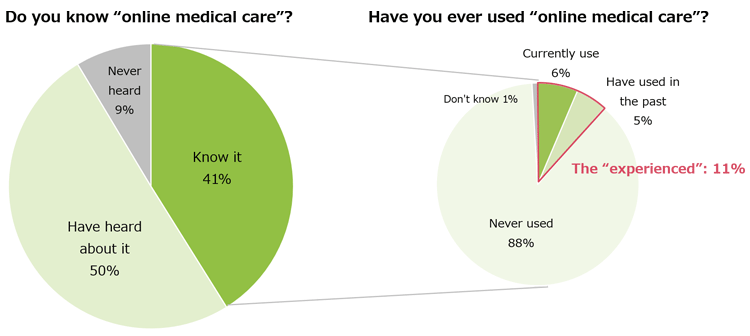
On the other hand, the intention to use, the sum of "want to use" and "somewhat want to use", accounted for 70%. The needs are high, especially among those in their 30s, 40s, and over 70s. Respondents under the 20s and 50s showed a low intention. This is partly because younger generations have less opportunity to get treated in the first place and they do not need it. People in their 50s have higher demands in receiving medical tests, and therefore their intention to use online medical services was low.
(*within people aware of the service but never used)
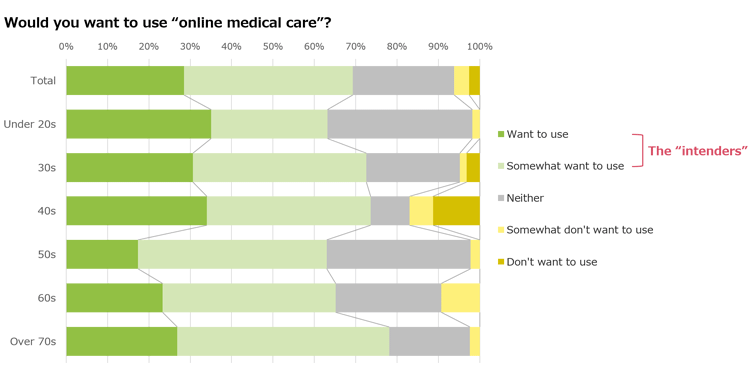
The “experienced”; those who had used the service, and the “intenders”; those who would like to use it in the coming future, were asked about the reasons for their choice. In overall, the experienced had a lower percentage than that of intenders, except for only one category -- "easy to make an appointment". This indicates that expectations were somewhat not met over the usage and resulted in the lowering of reasons-to-use for the “experienced”.
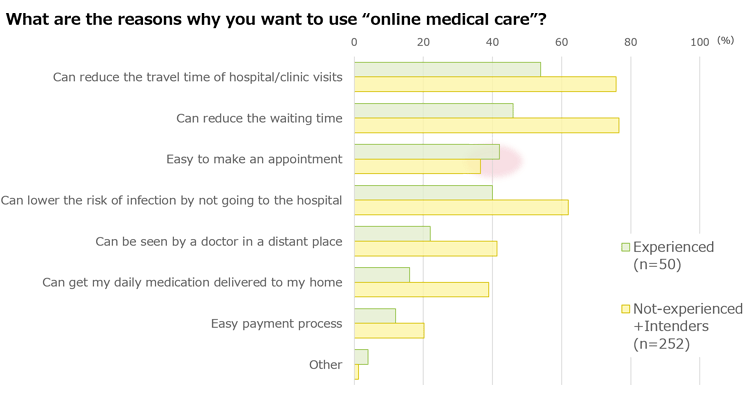
Concerns and dissatisfactions, such as "cannot receive tests and medical procedures" and "concerning the diagnosis, whether it is accurate without palpation", were common in both. Concerns over "describing symptoms properly" and "security, such as information leakage" were revealed as unique characteristics for the experienced. On the other hand, many of the intenders were dissatisfied with the fact that “family doctor does not support online medical services”. So, despite their willingness to use online medical services, they are unable to do so.
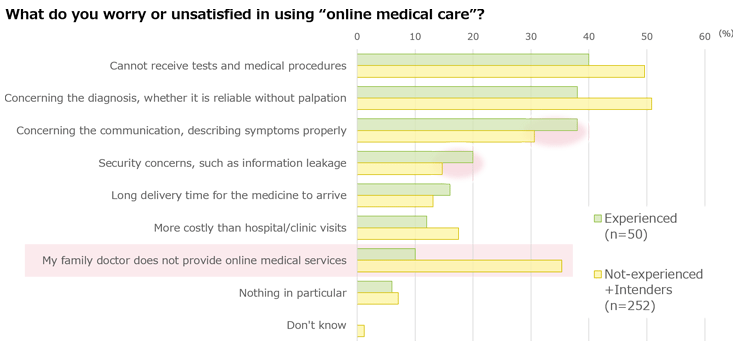
Weaknesses turn to new business opportunities
Simplifying the reservation and shortening the time of the patients’ appointment, is a strength, while uneasiness over the communication of symptoms and the worry over the accuracy of diagnosis where patients feel uncomfortable, is weakness. The familiarity of online medical care is still low, and these challenges are not easy to overcome, but it can turn to as an "opportunity" if the number of people who support is increased, meaning the potential of many users. Similarly, where their family doctors not providing online medical care and taken in the fact that this response is one characteristic of the intenders, it can be considered as an opportunity.
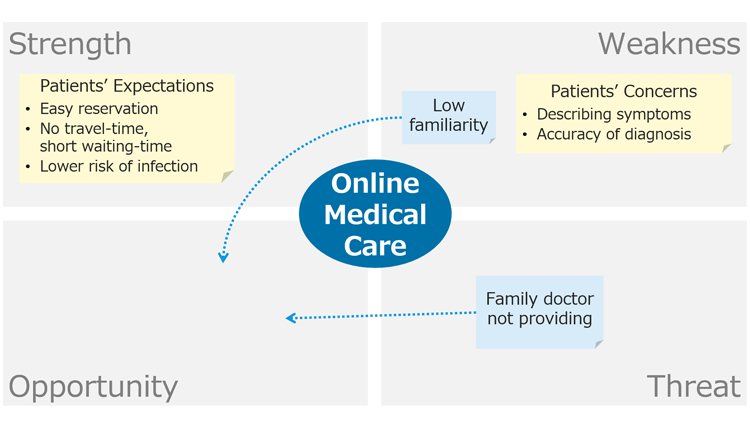
We can interpret “weaknesses” and "threats" to “opportunities” by aligning the research results with hypothetic. Getting a deep understanding of consumers and the implementation of infrastructures to medical institutions are activities done by companies that are providing online medical services, today. New opportunities may become apparent when we look from the perspectives of medical institutions or medical professionals, on what obstacles are lying upon the process of expanding.
Our survey asked basic questions of how people think about online medical care, but by conducting a survey tailored to the purpose and analyzing the results, the survey results can help uncover these “opportunities”. Further discussions with those data and insights will also help develop convincible action plans.
Collecting and using data from research in a new perspective
So what data do we need for building strategies today? How should we response in this dramatically changing environment, setting aside the surveys targeting physicians, pharmacists, and patients or information collected in the past?
As the business expands due to the change from healthcare to life-care, conducting surveys targeting not only patients but the whole consumer would be needed. Looking from the perspective of improving corporate value and social value, to consider whether the company's business is fully understood by stakeholders, including physicians and pharmacists with daily contacts, and how the company's brand image and directions are seen, are becoming more important. From an investment perspective, we also want to keep a close eye on the reaction of investors. Having a collaborative creation with various stakeholders and to be chosen as a partner by the target companies, to know how the company is evaluated in a company-to-company relationship and by businesspeople are also necessary.
The following two case studies of our clients show the importance of having a holistic view of the scope of the research and approaching to appropriate and sufficient pool of audiences.
Case 1
| Client | Pharmaceutical manufacturer |
|---|---|
| Background |
|
| Target |
|
| Use of Results |
|
Case 2
| Client | IT solution provider (AI drug development) |
|---|---|
| Background |
|
| Target |
|
| Use of Results |
|
Not surprisingly, the environment of medicine and healthcare is in the time of great change. Discovering opportunities from data and incorporating them into actions are essential for adapting. To do so, knowing the actual situation and understanding the issues correctly are critical.
-
Dec/14/2021
please contact us below.

